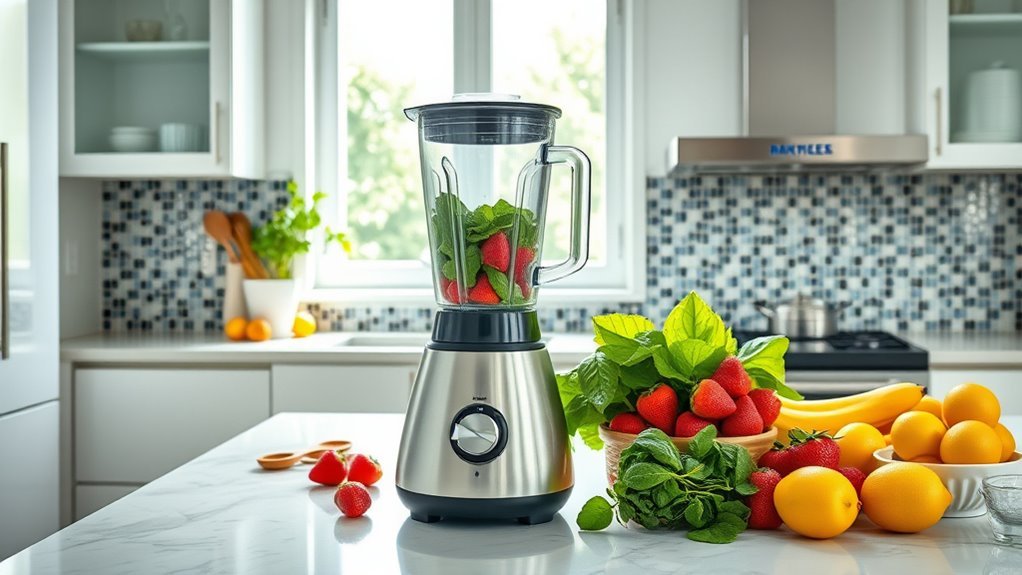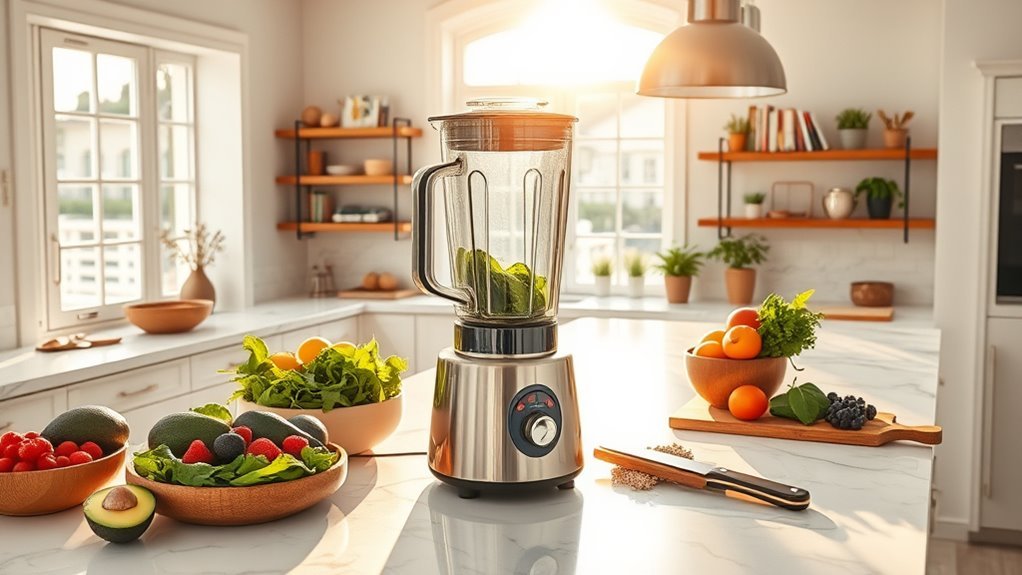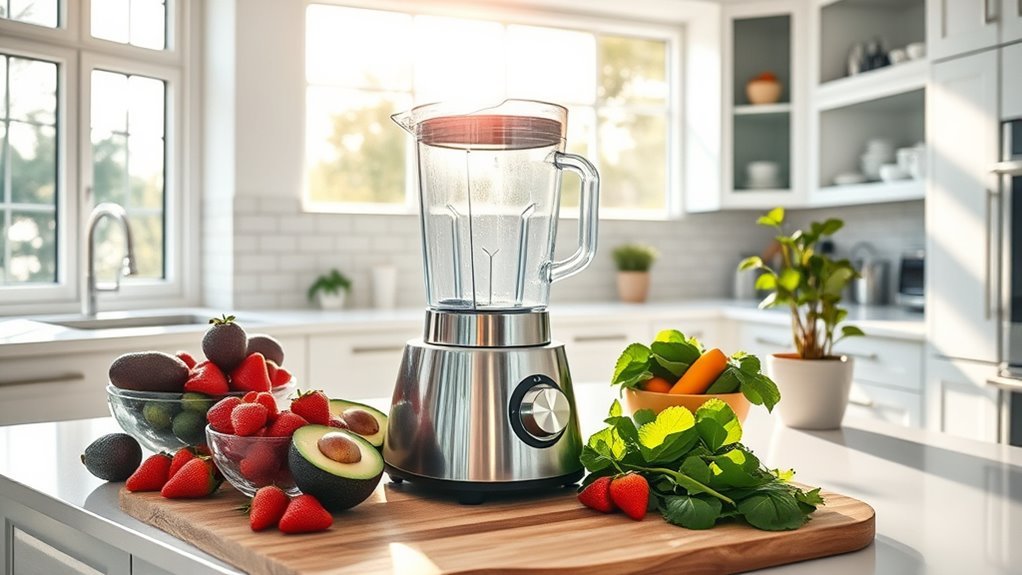When we’re mixing, blending, or processing ingredients, precise RPM control makes the difference between amateur and pro results. High speeds (up to 270 MPH) break down cellular structures and create ideal textures, while incorrect speeds can destroy delicate ingredients or create unwanted heat. Smart RPM selection prevents common disasters like accidentally churning cream into butter or destroying gluten structure in dough. There’s a whole science behind matching speeds to ingredients.
Understanding RPM’s Role in Food Processing Quality

While many home cooks focus solely on ingredients and cooking times, it’s the precise RPM (revolutions per minute) that often makes or breaks food processing quality. We can’t stress enough how RPM impacts every aspect of food preparation, from texture to flavor preservation.
Understanding material properties is essential – different ingredients react uniquely to various RPM settings. Too high, and we’re generating unwanted heat that degrades nutrients. Too low, and we’re missing the sweet spot for proper emulsification.
When we match RPM to specific food processing tasks, we’re not just following numbers – we’re orchestrating a precise mechanical dance that determines whether your whipped cream stays fluffy or your sauce maintains its silky consistency. It’s the difference between amateur mixing and professional-grade results. Additionally, using a high-performance blender can significantly enhance the efficiency and consistency of your food preparation.
The Science Behind Blade Speed and Ingredient Texture
As ingredients meet spinning blades, a fascinating physics experiment unfolds in your blender. We’re watching material removal at an impressive scale – at 10,000 RPM, those 3-inch blades hit surface speeds of 90 MPH, transforming chunky ingredients into silky smooth results.
Let’s get technical: High speeds create intense shear forces that break down cellular structures. We’re not just chopping here; we’re fundamentally altering food at the microscopic level.
That’s why your Vitamix 7500 hitting 270 MPH isn’t overkill – it’s engineering precision. These speeds don’t just blend; they emulsify, aerate, and transform textures. High-performance blenders with motor power exceeding 1,000 watts offer unmatched capability for achieving these results.
Want fluffy whipped cream? Silky smoothies? Perfect purees? It’s all about matching blade speed to your desired outcome. Slower for chunks, faster for smooth – that’s the physics of fantastic food prep.
Key Benefits of Proper Speed Selection

Precision in speed selection stands as the cornerstone of masterful food preparation.
We’ve found that proper RPM and feed rate control delivers game-changing results in the kitchen.
Let’s break down why speed control matters so much.
- High speed settings aerate ingredients perfectly, turning cream into clouds and batters into silk.
- Mid-range RPMs prevent splatter disasters while ensuring even distribution of ingredients.
- Lower speeds protect delicate components, letting you fold in berries without crushing them.
When we dial in the exact RPM needed, we’re not just following recipes – we’re maximizing efficiency and protecting our equipment.
The right speed slashes prep time, extends appliance life, and guarantees consistent results.
Think of it as speaking your mixer’s language: when you match speed to task, the magic happens.
Common RPM Mistakes and Their Impact
Despite good intentions, we’ve seen countless cooks sabotage their dishes with RPM blunders that could’ve been easily avoided. When we crank high speeds on stand mixers while kneading dough, we’re not being efficient – we’re destroying gluten structure and guaranteeing tough results.
Let’s be clear: RPM matters more than you think. Running food processors at excessive speeds? You’re cooking your nuts with friction instead of chopping them.
And don’t get us started on cream whipping – too many RPMs turns your would-be whipped cream into accidental butter. We’ve got to match lower speeds with delicate ingredients like eggs for proper emulsification.
These mistakes don’t just impact our final dishes – they accelerate tool wear and waste perfectly good ingredients. Smart RPM selection is non-negotiable for kitchen success.
Matching Speed Settings to Different Ingredients

Now that we’ve identified speed-related pitfalls, let’s master the art of matching RPMs to ingredients. The removal rate and depth of cut directly correlate with your speed settings, making precision essential for ideal results.
- Soft ingredients like ripe bananas demand gentle treatment at speeds 2-4, preserving their natural texture while ensuring thorough blending.
- Frozen fruits and tough vegetables require higher speeds (8-10) for efficient breakdown and consistent results.
- Dough kneading operates strictly at speed 2, while whipped cream needs speeds 8-10 for perfect peaks.
We’ll always start low and gradually increase speeds based on ingredient resistance.
Think of it as a dance – too fast, and you’ll overwhelm your ingredients; too slow, and you’ll never achieve the desired consistency.
Match your speeds precisely, and you’ll nail perfect textures every time.
Best Practices for RPM Control in Commercial Kitchens
While mastering RPM control separates the pros from the amateurs, we’ll show you how commercial kitchens maintain peak performance through strategic speed management.
Let’s cut straight to what works.
Monitor your speed range carefully – high RPM settings aren’t always better. We’ve learned that matching the right speed to each ingredient prevents quality loss and guarantees consistent results.
For dough, we keep it low. For whipping cream, we crank it up.
Here’s what the pros know: proper RPM control helps dissipate heat, which is vital for maintaining food safety and ingredient integrity.
We recommend regular speed adjustments based on what you’re preparing. Think of it like driving – sometimes you need highway speeds, other times you need to crawl.
Master this, and you’ll transform your kitchen’s efficiency overnight.
Frequently Asked Questions
What Is RPM in Blender?
We measure our blender speed in RPM (revolutions per minute), which shows how fast the motor power spins the blades, affecting our blending technique and recipe consistency.
Which Is the Best Food Processor?
We recommend comparing best brands like Cuisinart and KitchenAid through user reviews and feature analysis. For ideal value, consider price comparison across models offering versatile attachments and powerful motors.

